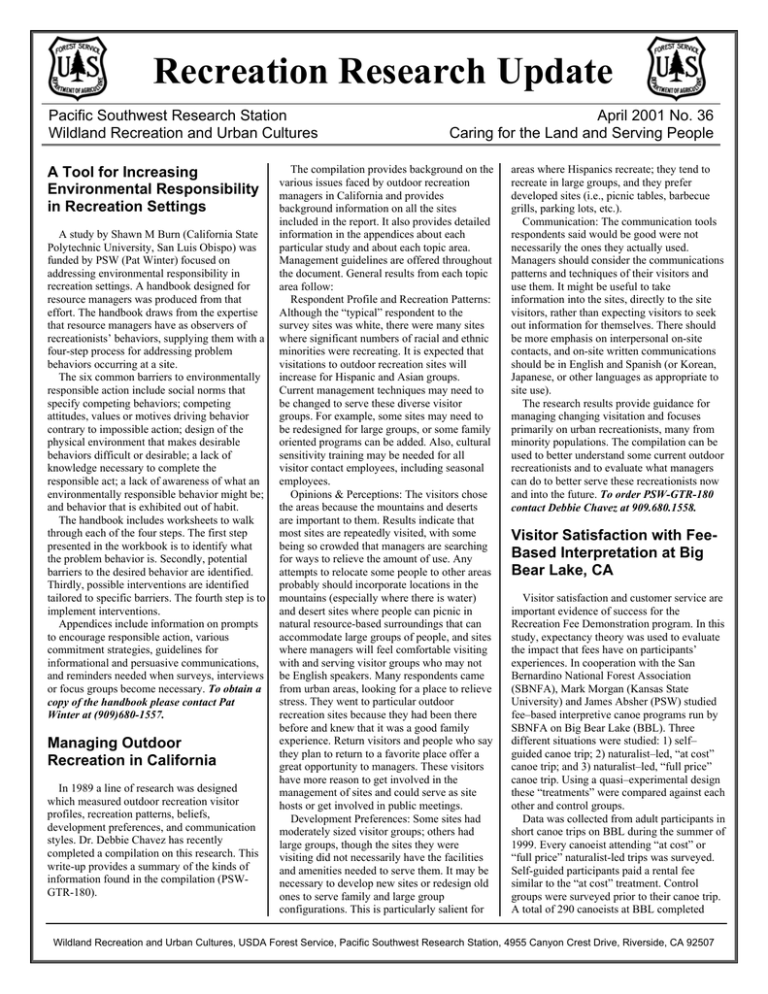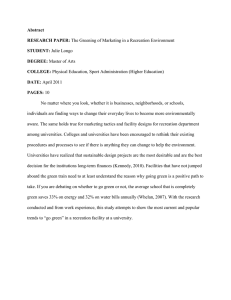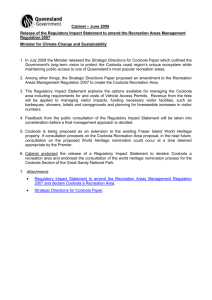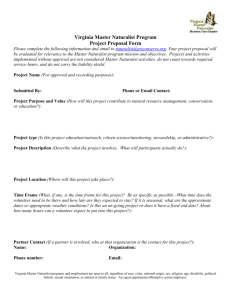Recreation Research Update
advertisement

Recreation Research Update Pacific Southwest Research Station Wildland Recreation and Urban Cultures A Tool for Increasing Environmental Responsibility in Recreation Settings A study by Shawn M Burn (California State Polytechnic University, San Luis Obispo) was funded by PSW (Pat Winter) focused on addressing environmental responsibility in recreation settings. A handbook designed for resource managers was produced from that effort. The handbook draws from the expertise that resource managers have as observers of recreationists’ behaviors, supplying them with a four-step process for addressing problem behaviors occurring at a site. The six common barriers to environmentally responsible action include social norms that specify competing behaviors; competing attitudes, values or motives driving behavior contrary to impossible action; design of the physical environment that makes desirable behaviors difficult or desirable; a lack of knowledge necessary to complete the responsible act; a lack of awareness of what an environmentally responsible behavior might be; and behavior that is exhibited out of habit. The handbook includes worksheets to walk through each of the four steps. The first step presented in the workbook is to identify what the problem behavior is. Secondly, potential barriers to the desired behavior are identified. Thirdly, possible interventions are identified tailored to specific barriers. The fourth step is to implement interventions. Appendices include information on prompts to encourage responsible action, various commitment strategies, guidelines for informational and persuasive communications, and reminders needed when surveys, interviews or focus groups become necessary. To obtain a copy of the handbook please contact Pat Winter at (909)680-1557. Managing Outdoor Recreation in California In 1989 a line of research was designed which measured outdoor recreation visitor profiles, recreation patterns, beliefs, development preferences, and communication styles. Dr. Debbie Chavez has recently completed a compilation on this research. This write-up provides a summary of the kinds of information found in the compilation (PSWGTR-180). April 2001 No. 36 Caring for the Land and Serving People The compilation provides background on the various issues faced by outdoor recreation managers in California and provides background information on all the sites included in the report. It also provides detailed information in the appendices about each particular study and about each topic area. Management guidelines are offered throughout the document. General results from each topic area follow: Respondent Profile and Recreation Patterns: Although the “typical” respondent to the survey sites was white, there were many sites where significant numbers of racial and ethnic minorities were recreating. It is expected that visitations to outdoor recreation sites will increase for Hispanic and Asian groups. Current management techniques may need to be changed to serve these diverse visitor groups. For example, some sites may need to be redesigned for large groups, or some family oriented programs can be added. Also, cultural sensitivity training may be needed for all visitor contact employees, including seasonal employees. Opinions & Perceptions: The visitors chose the areas because the mountains and deserts are important to them. Results indicate that most sites are repeatedly visited, with some being so crowded that managers are searching for ways to relieve the amount of use. Any attempts to relocate some people to other areas probably should incorporate locations in the mountains (especially where there is water) and desert sites where people can picnic in natural resource-based surroundings that can accommodate large groups of people, and sites where managers will feel comfortable visiting with and serving visitor groups who may not be English speakers. Many respondents came from urban areas, looking for a place to relieve stress. They went to particular outdoor recreation sites because they had been there before and knew that it was a good family experience. Return visitors and people who say they plan to return to a favorite place offer a great opportunity to managers. These visitors have more reason to get involved in the management of sites and could serve as site hosts or get involved in public meetings. Development Preferences: Some sites had moderately sized visitor groups; others had large groups, though the sites they were visiting did not necessarily have the facilities and amenities needed to serve them. It may be necessary to develop new sites or redesign old ones to serve family and large group configurations. This is particularly salient for areas where Hispanics recreate; they tend to recreate in large groups, and they prefer developed sites (i.e., picnic tables, barbecue grills, parking lots, etc.). Communication: The communication tools respondents said would be good were not necessarily the ones they actually used. Managers should consider the communications patterns and techniques of their visitors and use them. It might be useful to take information into the sites, directly to the site visitors, rather than expecting visitors to seek out information for themselves. There should be more emphasis on interpersonal on-site contacts, and on-site written communications should be in English and Spanish (or Korean, Japanese, or other languages as appropriate to site use). The research results provide guidance for managing changing visitation and focuses primarily on urban recreationists, many from minority populations. The compilation can be used to better understand some current outdoor recreationists and to evaluate what managers can do to better serve these recreationists now and into the future. To order PSW-GTR-180 contact Debbie Chavez at 909.680.1558. Visitor Satisfaction with FeeBased Interpretation at Big Bear Lake, CA Visitor satisfaction and customer service are important evidence of success for the Recreation Fee Demonstration program. In this study, expectancy theory was used to evaluate the impact that fees have on participants’ experiences. In cooperation with the San Bernardino National Forest Association (SBNFA), Mark Morgan (Kansas State University) and James Absher (PSW) studied fee–based interpretive canoe programs run by SBNFA on Big Bear Lake (BBL). Three different situations were studied: 1) self– guided canoe trip; 2) naturalist–led, “at cost” canoe trip; and 3) naturalist–led, “full price” canoe trip. Using a quasi–experimental design these “treatments” were compared against each other and control groups. Data was collected from adult participants in short canoe trips on BBL during the summer of 1999. Every canoeist attending “at cost” or “full price” naturalist-led trips was surveyed. Self-guided participants paid a rental fee similar to the “at cost” treatment. Control groups were surveyed prior to their canoe trip. A total of 290 canoeists at BBL completed Wildland Recreation and Urban Cultures, USDA Forest Service, Pacific Southwest Research Station, 4955 Canyon Crest Drive, Riverside, CA 92507 questionnaires during the summer of 1999. Nearly 100 percent of those asked responded to the survey. Questions were asked to measure canoeing motivations, perceptions of the naturalist, attitudes, knowledge, fees and demographics. An overall motive score was calculated as was an attitude scale that measured affective dimensions regarding the BBL ecosystem. A knowledge test measured the amount of information known by visitors about BBL ecology. Naturalist effectiveness ratings were included on post-trip questionnaires. Visitors were also asked eight fee-related questions. Demographic and use data consisted of age, race, gender, primary residence, zip code, travel distance, and previous visits to BBL. Using SPSS, scores for each dependent variable (motives, attitudes, knowledge, naturalist and fees) were compared against each other to determine if they were significantly different. Hypotheses were tested using a one–way Analysis of Variance and the Student-Neuman–Keuls multiple comparison test, as appropriate. Based on demographic and use variables, those participating in the naturalist led trips were largely the same as those engaged in self– guided trips. Participants’ overall expectation (before canoeing) and satisfaction (after the trip) were similar among groups, and suggest that canoeists had high expectations about their trips and received many benefits from participation. Motivation or satisfaction scores revealed that that participants in the control groups arrived at BBL with similar motivations about canoeing. On the other hand, satisfaction differed significantly: the “at cost” and “full price” naturalist–led groups reported that the naturalist had a positive effect on their canoeing experience. Significant gains in BBL attitudes and knowledge were attributable to naturalist involvement as well. Fee attitudes measures showed that naturalist–led trips were different from self–guided canoeists, but not from each other. Participants’ willingness-to-pay (WTP) for an interpretive program varied from $9.21 to $17.13. The WTP amounts varied significantly across groups. WTP for a children’s canoe trip (naturalist–led) varied as well, ranging from $3.86 to $9.38. Asked if they thought the trip (would be or was) worth the cost, control groups and treatment groups scored high. Canoeists in the low–cost naturalist led group valued the trip more once they had completed it. The data strongly suggest that naturalist–led canoe programs at BBL are very successful. Canoeists received numerous benefits from participation, as evidenced by high satisfaction scores in the natural-led trips. Virtually every treatment showed a positive increase in scores when compared to control groups. By offering this type of service, the SBNFA is increasing visitor awareness of the Big Bear Valley and generating some much needed revenue for operational expenses. Judging from these results, participants seemed to be very satisfied with the naturalist conducting the interpretive program. Self-directed canoeists made no appreciable gains in knowledge, but both naturalist–led groups improved their scores significantly. On fiscal policies, both naturalist–led trips had higher levels of support for fees than the self–directed canoeists. Every group thought the canoe trip would be (or was) worth the money spent. Other data suggest the BBL canoe trips may be overpriced. Overall, the BBL fee–based interpretation is a success, especially as an information delivery activity. Finding ways to make it financially sound seems to be the larger challenge. For more information about this study contact Jim Absher at 909.680.1559. Summary Website for the Socioeconomic Assessment from Southern California In previous updates we have described an ongoing socioeconomic assessment for twentysix counties in southern California, being conducted by Rachel Struglia and Pat Winter. The assessment includes an atlas, prepared by the Pacific Northwest Research Station’s Terry Raettig, Dawn Elmer and Chris Christensen. We have recently created a website, with the handiwork of Dave Olson (PSW), which presents information on population, ethnic and racial diversity, the region’s economic base, employment, various quality of life indices, population projections, human forest-linkages, and a summary of focus groups conducted in cooperation with George Cvetkovich of Western Washington University. Key findings within the population section show the comparatively high rate of growth in California compared to the rest of the nation, and higher concentrations of population in Los Angeles and San Diego Counties. The section focused on ethnic and racial diversity reveals the largest percent increase among county populations accounted for by Hispanics or Latinos in the majority of counties, followed by Asian/Pacific Islanders in four counties of the San Francisco Bay Area. The most diverse area in 1990 was the SCAG region, followed by the Central Valley. The SCAG region also has the highest proportion of students that are limited-English proficient. The majority of limited-English proficient students speak Spanish in 24 of the assessment area’s counties. Economic base is examined in terms of economic diversity, non-farm earnings, acres of agricultural land, per capita income maintenance, prior year payments, poverty estimates, and building trends. Economic diversity in the region has been relatively stable since 1990, and is highest in the counties along the Pacific Coast. The employment section presents total employment, trends in wages, average earnings per job, employment outside of the county, and unemployment. Employment indicators reflect the effects of the recession in the late 80s and early 90s, though wages in the region have been higher than the national average wage per job for more than two decades. Quality of life indicators include owner and renter-occupied housing units, median values of owner-occupied housing and median rents, average number of vehicles per household, average commute time to work and commuting methods, school enrollment and academic achievement, alcohol involved automobile collisions, reported crimes and crime rates, watershed quality and annual emissions. The section on population projections shows an expected increase in population in the region through 2040, increased ethnic and racial diversity, and increasing median age among some population subgroups. To view the socioeconomic summary on our website go to: www.rfl.psw.fs.fed.us/recreation/assessment _social/assessment_summary.html Recent Publications Chavez, D.J. 2001. Managing outdoor recreation in California: Visitor contact studies 1989-1998. Gen. Tech. Rep. PSW-GTR180. Albany, CA: Pacific Southwest Research Station, Forest Service, U.S. Department of Agriculture; 102 p. Chavez, D.J. 2000. Invite, include, and involve! Racial groups, ethnic groups, and leisure. In. M. T. Allison and I.E. Schneider (Eds.) Diversity and the Recreation Profession: Organizational Perspectives. State College, Pennsylvania: Venture Publishing, Inc.; 179194. Chavez, D.J. 2000. Wilderness visitors in the 21st century: Diversity, day use, perceptions and preferences. International Journal of Wilderness 6 (2): 10-11. Chavez, D.J.; Tynon, J.F. 2000. Triage law enforcement: Societal impacts on national forests in the west. Environmental Management 26 (4): 403-407. Morgan, M. & Absher, J. 2001. Visitor satisfaction with fee-based interpretation at Big Bear Lake, CA. RWU–4902 Technical Report. Riverside, CA: USDA Forest Service, Pacific Southwest Research Station; 45 p. Tynon, J.F.; Chavez, D.J.; Kakoyannis, C. 2001. If you go down to the woods today, you’re sure of a big surprise: It’s no teddy bear’s picnic. Women in Natural Resources 22 (1): 6-17. Debbie Chavez, Update Coordinator ☀ 909.680.1558 ☀ email: dchavez@fs.fed.us ☀ http://www.rfl.psw.fs.fed.us/recreation/index.html





